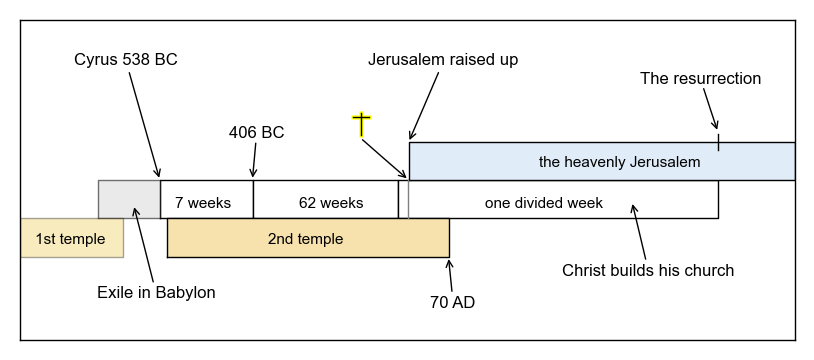Does John interpret Daniel’s 70 weeks prophecy?
Several elements of the prophecy of the 70 weeks, in Daniel 9:24-27,
are also evident in Revelation 12, which suggests that John’s prophecy
interprets and explains several aspects of Daniel’s prophecy,
especially the things pertaining to the 70th week. Common elements in
the two prophecies are listed in the following table.
| Daniel 9:24-27 | Revelation 12 |
|---|---|
| holy city, Jerusalem | woman in heaven, new Jerusalem |
| Christ confirms the covenant | Christ is caught up to the throne of God |
| war causing desolation | war in heaven |
| wing | two wings of an eagle given to the woman |
| flood | flood from the mouth of the serpent |
| one who makes desolate in judged | dragon, Satan cast out |
| half week | time, times and a half |
| something is poured out on the desolate | the earth opens its mouth and swallows up the serpent’s flood |
Some insist that Daniel’s 70 weeks apply only to ethnic Jews, but in the prophecy itself Daniel makes reference to God’s “holy mountain,” which is identified with the kingdom of God in Daniel 2:35. The church is the “holy mountain.” When Jesus ascended to heaven, depicted in Revelation 12:5, Jerusalem was also raised up, fulfilling Isaiah 2:1-3. Thus the woman who represents the church is shown in heaven, in Revelation 12:1. John identifies her as the new Jerusalem and the bride of the Lamb in Revelation 21:9-10.
In that chapter the dimensions of the holy city are given in units of furlongs and cubits, but John qualifies these units by saying that the cubits are “according to the measure of a man, that is, of the angel.” [Revelation 21:17] They are not natural cubits, but have an angelic or spiritual character. The dimensions of a wall require more than one number; width, height and length are needed for a proper description. But John provided only one number, which is obviously symbolic. The same applies to the dimensions of the city. If the 144 cubits refers to the wall’s height, the city is about 36,666 times higher than its wall!
Similarly the time units that apply to the heavenly city are
symbolic, rather than natural or earthly units. The sections of the 70
weeks prophecy that apply to the earthly city are fulfilled in natural
years, and weeks of years, or weeks of leap years, but the portion of
the 70 weeks that applies to the heavenly city is symbolic time.
The last half of the 70th week applies to the heavenly Jerusalem, the
church. The part of the seventieth week, in which Christ confirms the
covenant with many, is not natural time units, but symbolic. This is
illustrated in the graphic below.

The final half of the 70th week applies to
the heavenly Jerusalem
The wing of abominations mentioned in Daniel 9:27 (in some translations, but not the KJV) can be understood by comparison with the two wings of an eagle that are given to the woman, and by wings mentioned in the prophecy of Daniel 7. The wings of an eagle allude to the wings mentioned in Exodus 19:4, where God figuratively bore the Israelites on the wings of an eagle, as they were delivered from Egypt. The wings of an eagle possessed by the first of the four beasts, which were plucked off, represent the prophetic understanding given by God to king Nebuchadnezzar. The inferior wings of a fowl on the third beast seem to picture the pagan superstition that characterized the Greek hellenistic period. Thus the “wing of abominations” in Daniel 9:27 must be an inferior wing, representing superstition and flawed, inferior interpretations of prophecy.
The flawed interpretations, the “flood from the mouth of the serpent” that threatens to carry away the woman in Revelation 12:15, is swallowed up by the earth, or the land. I suggest this alludes to the promised land, which represents the spiritual inheritance promised to the church, including the promise of Jesus in John 13:13 that the Spirit will guide the saints into all truth. The truth destroys the serpent’s flood of flawed interpretations.